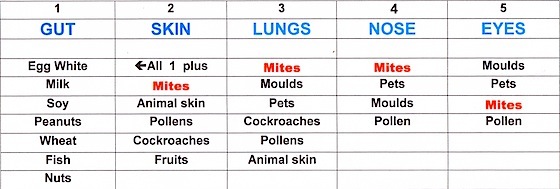Why study the major cause of allergy, the house dust mite?
Allergy is fast becoming an epidemic in the developed world and house dust mites are recognised as a major cause of asthma, rhinitis and dermatitis. Allergic disease is costly to the patient, to society, and asthma can kill.
Up to one in three children in Europe suffers from allergy, and overall 35% of the population is affected. Westernised populations born after the 1980 will perceive allergic eczema and the accompanying atopic state as a major public health problem.
Allergic diseases vary in different countries and within countries it may vary between regions. Social environments, climate and life style all may have an effect on the outcome of a genetic predisposition to allergy. Most allergic diseases are chronic and relapsing, 10% of patients, diagnosed as severe and chronic, account for 60% of the total health cost. It is in the public interest to identify these people early and control the potential march of allergic disease.
From early studies on large populations born in the1950s scientists have been able to observe the march of allergy in western society. They have identified a vulnerable group of people along with major environmental risk factors that impact negatively upon their health. The scientists are working on the genetic 'fingerprinting' of these people to identify methods to reduce the risks from allergic disease. They have clearly warned us that there is no easy pathway. Help will come in the form of an educated public choosing a selected diet and life style combined with avoiding known environmental and stress related risk factors.
Established allergies may be able to attack one or more organs in allergic disease. Most noticeable and common are lungs (asthma) nasal passages (rhinitis) eyes (conjunctivitis) and skin (eczema). In severe and chronic allergic disease, one, two or maybe all may be present and lead to a reduction of the patient's quality of life.
COMMON CAUSES OF ALLERGY IN CHILDREN AND THE TARGET ORGAN

UCB Institute of Allergy. European Allergy White Paper, 1997
Eczema is often the first indicator in patients that there may be a problem with allergy and is frequently of long duration and persistent. It is associated with a reduced quality of life and is associated with asthma. At this time the fundamental genetic cause of allergic eczema remains unknown but the risk factors that accelerate the disease progress are well known and mites are among these risk factors.
Fast facts about house dust mites
Latin names 'Dermatophagoides pteronyssinus' and 'Dermatophagoides farinae'. These two common house dust mites are close relative that share the same allergens. They live in colonies and can be found worldwide in dark, damp, warm and still nest sites such as mattresses, sofas, pillows, blankets or soft toys. The mite has no eyes, never drinks, yet is 75% water. Its life depends upon absorbing moisture from its surrounding environment. The mite does not breath, but gets oxygen through its outer shell like covering. It eats organic matter including discarded mouldy skin scales, pollen, bacteria, fungi, cotton fibre, damp wheat or corn flour, and scales from dead insects.
Like rabbits the house dust mite considers it dropping as nourishment. A healthy breeding adult can produce up to 20 droppings a day, each one packed full of enzymes designed to breakdown leftover or hard to digest food. Allergic diseases caused by mite exposure are allergic rhinitis and asthma, 80% of asthmatic children in the UK are allergic to the house dust mite.
The UCB institute of allergy. European Allergy White Paper; Allergic disease as a public health problem.Braine-l' Alleud: UCB Pharmaceutical Sector, 1997.
'Dust Mite Allergies and Asthma - A worldwide Problem', Platts Mills TAE, de Weck A, UCB Institute of Allergy, Bad Kreuznach September 1987. Reported in The Journal of Allergy and Clinical Immunology, 1989: 83:416-427
'The Biology of Allergenic Domestic Mites, An Update', Barbara J. Hart, 1995 Humana Press Inc, 'Clinical Reviews in Allergy and Immunology', 13:115-133.
'House Dust Mite Der p 1 Downgrades Defences of the Lung by Inactivating Elastase Inhibitors', Brown A, et al, 'Am.J.Respir.Cell Mol. Biol'. 2003 vol 29;381-389

